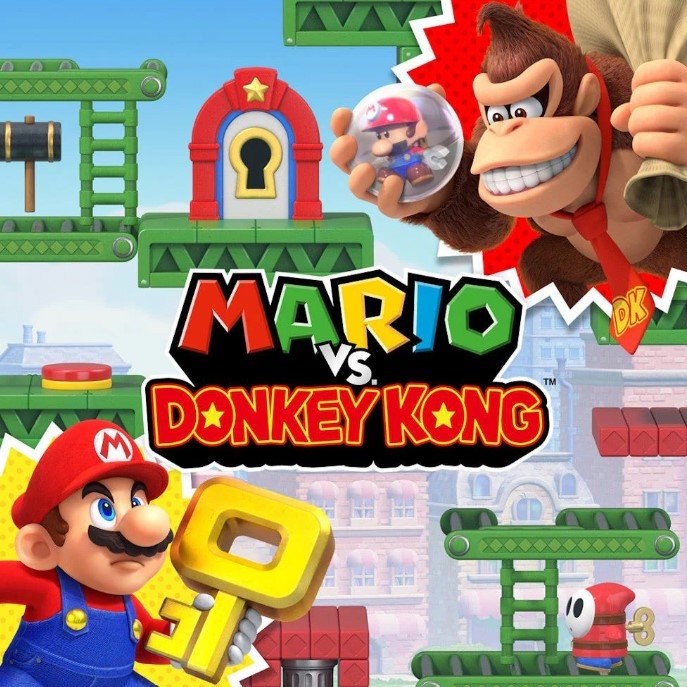The Epic Saga of Mario vs. Donkey Kong: A Timeless Clash of Titans
In the vast realm of gaming, few rivalries stand as iconic and enduring as that between Mario and Donkey Kong. Their clash has spanned decades, evolving with each iteration, yet retaining the essence of classic gameplay that has captivated generations. From the arcades of the 1980s to the modern consoles of today, the battle between plumber and ape continues to enthrall players worldwide. Join me as we delve into the intricate world of “Mario vs. Donkey Kong,” exploring its rich storyline and addictive gameplay.

The Storyline
The saga of “Mario vs. Donkey Kong” begins with a classic tale of love and rivalry. Donkey Kong, the mischievous ape, becomes infatuated with the beautiful Pauline, Mario’s erstwhile love interest. In a fit of jealousy, Donkey Kong kidnaps Pauline and retreats to his lair, prompting Mario to embark on a daring rescue mission. Thus, the stage is set for an epic showdown between hero and villain.
As the series progresses, the narrative evolves beyond a simple rescue mission. Donkey Kong’s antics lead to a series of misadventures, involving his constant attempts to thwart Mario’s efforts and wreak havoc in the Mushroom Kingdom. From kidnapping Pauline to causing chaos in Mario’s toy factory, Donkey Kong’s schemes test Mario’s courage and ingenuity at every turn.

However, amidst the chaos, a new protagonist emerges – Mini Mario. These miniature versions of Mario serve as the key to solving puzzles and navigating treacherous obstacles. As the series unfolds, Mini Mario takes center stage, embarking on his own quests to save his friends and thwart Donkey Kong’s machinations.
Gameplay
At its core, “Mario vs. Donkey Kong” is a puzzle-platformer that combines elements of strategy, timing, and quick reflexes. Players control Mario (and later Mini Mario) as they navigate through increasingly complex levels filled with hazards, enemies, and environmental obstacles.
The gameplay mechanics vary slightly across different iterations of the series, but the core objectives remain consistent. Players must guide Mario or Mini Mario through each level, collecting keys, coins, and other items while avoiding traps and enemies. The ultimate goal is to reach the end of the level and rescue Pauline (or another character) from Donkey Kong’s clutches.
One of the defining features of the series is the introduction of the “Mini Mario” toys, which players must escort safely to the exit. These miniature versions of Mario possess unique abilities, such as the ability to walk on ceilings or activate switches, adding an extra layer of complexity to the puzzles.
In addition to the main story mode, “Mario vs. Donkey Kong” offers a variety of additional gameplay modes, including puzzle levels, time trials, and multiplayer challenges. These modes provide players with endless opportunities for exploration and competition, ensuring that the game remains engaging long after the main storyline is complete.
A Visual Odyssey through Time and Adventure
“Mario vs. Donkey Kong” is not just a clash of iconic characters but also a visual spectacle that has evolved over the years, adapting to changing technologies while staying true to its classic roots. From its humble beginnings in the arcade to its modern iterations on handhelds and consoles, the series has undergone a remarkable transformation in terms of graphics and art style. Let’s embark on a visual journey through the various iterations of “Mario vs. Donkey Kong,” exploring how its visuals have evolved over time.
The Classic Era: The original “Donkey Kong” arcade game, released in 1981, introduced players to the pixelated world of Mario and Donkey Kong. Despite the limited graphical capabilities of the time, the game’s visuals were groundbreaking, featuring vibrant colors and expressive character sprites. Players were immediately drawn into the action-packed levels, filled with ladders, platforms, and obstacles, all rendered with charming simplicity.
As the series progressed through the 1980s and 1990s, with sequels like “Donkey Kong Jr.” and “Donkey Kong 3,” the visuals remained true to the arcade aesthetic, with incremental improvements in sprite design and animation. The iconic imagery of Mario leaping over barrels and climbing ladders became ingrained in the collective consciousness of gamers worldwide, setting the stage for future iterations of the series.
The Modern Era: With the advent of more powerful hardware in the late 1990s and early 2000s, the “Mario vs. Donkey Kong” series underwent a visual renaissance. The transition from 2D sprites to 3D models opened up new possibilities for character design and level environments, allowing for greater detail and immersion.
In “Mario vs. Donkey Kong” for the Game Boy Advance, released in 2004, players were treated to lush, colorful worlds rendered in vibrant pixel art. The characters were more expressive than ever, with fluid animations bringing Mario, Donkey Kong, and their friends to life in ways previously unseen. The visual design of the game struck a perfect balance between nostalgia and modernity, appealing to fans both old and new.
Subsequent entries in the series, such as “Mario vs. Donkey Kong: Mini-Land Mayhem!” for the Nintendo DS, continued to push the boundaries of visual fidelity. The introduction of stereoscopic 3D effects added depth and dimension to the gameplay experience, immersing players in a world teeming with detail and personality. From the intricate designs of the Mini Mario toys to the dynamic environments filled with interactive elements, every aspect of the game’s visuals was crafted with care and precision.
The Future: As we look to the future, the visual evolution of “Mario vs. Donkey Kong” shows no signs of slowing down. With each new installment, developers continue to push the boundaries of what’s possible, harnessing the latest technologies to create immersive gaming experiences that captivate and inspire.
Whether it’s the vibrant colors and pixel-perfect nostalgia of the classic arcade era or the stunning 3D graphics and dynamic environments of the modern era, one thing remains constant – the timeless appeal of Mario and Donkey Kong’s epic rivalry. As long as gamers continue to seek adventure and excitement, the visual spectacle of “Mario vs. Donkey Kong” will continue to delight and amaze audiences for generations to come.

Pingback: Still Wakes the Deep v4: Echoes from the Abyss
Pingback: Squad buster v1